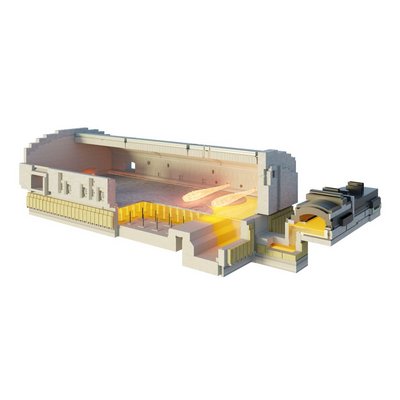Addressing the industry’s decarbonisation challenge, HORN is taking the next step forward in the industry´s transition to a resource-efficient and low-carbon economy. Since the glass industry is committed to climate-neutral packaging, hybrid furnaces have been developed and evaluated by HORN as a potential and promising technology to reduce carbon dioxide emissions.
Hybrid furnaces seek to replace a large share of the currently used natural gas by electricity. HORN defines a furnace in general as hybrid if both forms of power, electric and fossil, are needed for sufficient operating. Depending on the kind of furnace, the window for the electric share reaches from 20% up to 80%.
In the combustion space the location of multiple oxygen burners along the side walls enables a precise regulation of the temperature distribution by adjusting the gas distribution accordingly.
For a high share of electric power, for example, the gas distribution can be shifted more towards the refining area, while the energy in the melting area is predominantly provided via the electrodes. This increases the energy flexibility even more, compared to the Hybrid End Fired Furnace.
Starting from a continuous combustion space, the furnace can be operated with up to 80% electric power, with a minimum of around 20%. Compared to a completely fossil oxyfuel furnace, the CO2-emissions regarding the melting can be reduced up to 50%.
FEATURES
• Low carbon footprint
• Electric energy input up to 80%
• Flexibility of electric boosting
• High glass quality possible
• Low specific energy consumption (< 3 GJ)
At glasstec 2024, HORN presents the possibilities of using electrical energy in the glass melting process in the form of Hybrid Furnaces, Super Hybrid Furnaces or All Electric Furnaces. Feel free to visit us at our booth C32 in hall 13.
Further informations at https://www.hornglass.com/products/melting-furnaces-and-equipment/hybrid-furnaces
